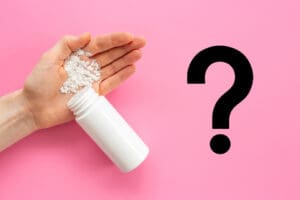Introduction
Johnson & Johnson, the US-based international pharmaceutical giant, stands among the top three pharmaceutical companies worldwide based on projected sales of 55.2 billion USD in 2022.
Despite its seemingly booming business, the company is facing 37,447 lawsuits regarding the presence of the carcinogen asbestos in one of its most popular products, J&J’s talc-based baby powder. These cases are costing J&J over 4 billion USD in settlements.
Along with the financial strain the asbestos-linked baby powder cases have inflicted on the company, recently revealed documents unearth a new controversy surrounding the talc-based baby powder that roots back to J&J’s past in the 1960s and 1970s.
So, what exactly is this new development in Johnson & Johnson’s baby powder controversy?
According to court documents describing a prison study conducted in 1971 with Dr. Albert Kligman, J&J was injecting talc and asbestos into predominantly black inmates to observe and compare the results of the two chemicals.
What You Need to Know About the J&J controversy-
What are the ongoing lawsuits regarding J&J’s talc-based baby powder?
In December 15th, 2021, 37,447 lawsuits were filed against J&J for the presence of asbestos in its talc powder. The company faces a cost of over 4 billion USD in settlements.
Asbestos is a mineral that is commonly found with talc. It is recognized as a cancer-causing agent by the U.S. Department of Health and Human Services (HHS), the U.S. Environmental Protection Agency (EPA), and the International Agency for Research on Cancer (IARC).
Over the years, studies have provided evidence linking the development of mesothelioma, lung cancer, ovarian cancer, and laryngeal cancer with asbestos exposure.
Between 2009 and 2010, the FDA reported that it could not prove that talc-based products had no asbestos contamination.
The baby powder lawsuits that J&J is facing claim that the company knew that its talc-based baby powder contained traces of asbestos, and yet it did not issue warnings to consumers, putting them at an increased risk of developing cancer.
Between 2009 and 2013, the first talc-based powder lawsuit was filed against J&J by Deane Berg, who was diagnosed with ovarian cancer in 2006.
Since then, people have continued to file lawsuits against the company for their lack of transparency and their failure to issue appropriate warnings regarding their product.
Now, the newest development in the J&J controversy is the company’s involvement in experimenting on black inmates in Philadelphia.
How has J&J responded to its talc-based baby powder lawsuits?
As a result of the lawsuits, J&J is estimated to be spending over 4 billion USD on settlements. Adding to their woes, the company also stopped selling talc-based baby powder in the U.S. and Canada in 2020.
Throughout the lawsuits, J&J has consistently stated that there has been no asbestos in its talc. Currently, the talc-based powder lawsuits are on hold as the company has set up a subsidiary called LTL Management LLC and has filed for bankruptcy protection to protect its assets.
Among its responses to the lawsuits, one of J&J’s actions has been deemed controversial as the company made use of the “Texas Two-Step” to try and bring down the costs of the litigation process.
The prison was a ground for Dr. Kligman’s experimentation for more than 20 years, with tests and studies sponsored by the likes of Dow Chemical and the U.S. government. What is new though is the knowledge of Johnson & Johnson’s involvement in these experiments with Dr. Kligman.
Details on J&J experimenting on black inmates in the 1960’s
What is the company’s history regarding testing talc powder on black inmates?
In 1971, Johnson & Johnson funded an experiment led by Dr. Albert Kligman, a dermatologist from the University of Pennsylvania.
The experiment was based in Pennsylvania, where 10, predominantly black, inmates from Massachusetts’s Holmesburg prison were offered between 10 to 300 USD to participate in the study.
This study was referred to as the “asbestos test” and it consisted of Dr. Kligman injecting the prisoners with tremolite and chrysotile asbestos along with a talc shot in their lower backs. The purpose of this experiment was to study and compare the effects of talc and asbestos on human skin.
Although Dr. Kligman’s human experimentation was public knowledge, what is new is the fact that Johnson & Johnson was involved in these experiments with him.
How did the experiment affect its participants and their families?
After Kligman’s 1971 human experiment was concluded, David Egilman, a medical professor from Brown University represented the plaintiffs as a specialist in their cases.
Egilman determined that chrysotile asbestos had the most severe effect on the inmates’ skin and resulted in the formation of granulomas.
Leodus Jones, one of the participants of Kligman’s studies, described the scars on his back that were formed due to the injection of asbestos. His daughter, Adrianne Jones-Alston recalls how terrified she was when she saw her father’s maimed skin for the first time.
“I was four or five when I first saw my father’s back and it scared me so badly, I ran to my mother and told her that daddy had turned into a monster.”
Adrianne Jones-Alston
What was the role of Dr. Kligman in the experiments?
Dr. Albert Kligman was a dermatologist from the University of Pennsylvania, and he was known for his human experimentation on prisoners in the Holmesburg prison.
Dr. Kligman first visited the prison in 1951, to treat athlete’s foot, but upon observing the vast number of prisoners available he began hiring them as test samples for his studies.
The prison was a ground for Dr. Kligman’s experimentation for more than 20 years, with tests and studies sponsored by the likes of Dow Chemical and the U.S. government.
After court documents revealed more information regarding the doctor’s unethical human experimentation, the University of Pennsylvania apologized on the dermatologist’s behalf, despite Dr. Kligman himself never admitting to any malpractice till his death in 2010.
In the late 1990s, he reported to the Baltimore Sun, “My use of paid prisoners as research subjects in the 1950s and 1960s was in keeping with this nation’s standard protocol for conducting scientific investigations at the time.”
J&J’s current stance on the allegations
What does J&J say about its unethical experiments?
To date, Johnson and Johnson is denying the presence of asbestos in its talc powder. Although the company admits to hiring Dr. Kligman in 1971 for the asbestos test, it states that its work, although unacceptable today, was deemed normal at the time, considering that the U.S. government itself was involved in testing prison inmates.
J&J’s representative, Kim Montagnino states, “We deeply regret the conditions under which these studies were conducted, and in no way do they reflect the values or practices we employ today. As the world’s largest healthcare company, our transparent, diligent approach to bioethics is at the heart of all we promise our customers and society.”
Although the pharmaceutical giant is apologetic for working with Dr. Kligman, it does not admit to transgressing the standard research protocol of that time.
What steps can victims of the company’s experimentation take?
Although victims and their families have not yet sued Johnson and Johnson for its unethical involvement in human experimentation, they need to take a stand against the company’s actions that impaired lives, such as those of Leodus Jones.
After Leodus Jones died in 2018 at the age of 74, his daughter, Adrianne-Jones Alston began urging the University of Pennsylvania to compensate the participants of Dr. Kligman’s human experiments.
Readers who have family members who were involved in the tragic experimentation are also urged to raise their voices and hold both J&J and the University of Pennsylvania accountable for their actions.
This is especially important because it was only after public outcry that Dr. Kligman’s unethical experiments were put to an end in 1974.
Conclusion
In the end, we have enough evidence to prove the carcinogenicity of asbestos as well as conclusive findings that depict the presence of asbestos in talc, making Johnson & Johnson’s baby powder unfit for consumers.
The recent revelation of J&J’s involvement in unethical human experimentation where they subjected predominantly black test subjects to cruel procedures simply to compare talc and asbestos not only highlights the association between the two substances but also displays a callous, biased image of the global pharmaceutical giant.
This is why, if you or a loved one is suffering from cancer after being exposed to the company’s talc powder, it is in your best interest to file a lawsuit and get the compensation you deserve.
Along with this, it is important to keep raising your voice about the company’s unethical experimentation so that victims of the 1971 study and their family members can be delivered justice.




